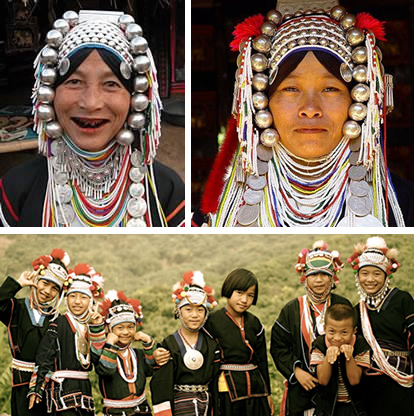The Hill Tribes of Northern Thailand
 Hill tribe (Thai: ชาวดอย, ชาวเขา, คนเขา,, Thai pronunciation: [tɕʰāːw.dɔ̄ːj, tɕʰāːw.kʰǎw, kʰōn.kʰǎw]) (Northern Thai: จาวดอย, คนดอย, Northern Thai pronunciation: [t͡ɕāːw.dɔ̄ːj, xōn.dɔ̄ːj]; “mountain people/folk”) is a term used in Thailand for all of the various ethnic groups who mostly inhabit the high mountainous Northern and Western regions of Thailand, including both sides of the border areas between Northern Thailand, Laos and Burma, the Phi Pan Nam Range, the Thanon Range, the latter a southern prolongation of the Shan Hills, as well as the Tenasserim Hills in Western Thailand. These areas are known for their often mountainous terrain which is in some areas covered by thick forests, while in others it has been heavily affected by deforestation.
Hill tribe (Thai: ชาวดอย, ชาวเขา, คนเขา,, Thai pronunciation: [tɕʰāːw.dɔ̄ːj, tɕʰāːw.kʰǎw, kʰōn.kʰǎw]) (Northern Thai: จาวดอย, คนดอย, Northern Thai pronunciation: [t͡ɕāːw.dɔ̄ːj, xōn.dɔ̄ːj]; “mountain people/folk”) is a term used in Thailand for all of the various ethnic groups who mostly inhabit the high mountainous Northern and Western regions of Thailand, including both sides of the border areas between Northern Thailand, Laos and Burma, the Phi Pan Nam Range, the Thanon Range, the latter a southern prolongation of the Shan Hills, as well as the Tenasserim Hills in Western Thailand. These areas are known for their often mountainous terrain which is in some areas covered by thick forests, while in others it has been heavily affected by deforestation.
The hill dwelling peoples have traditionally been primarily subsistence farmers who use slash-and-burn agricultural techniques to farm their heavily forested communities. Popular perceptions that slash and burn practices are environmentally destructive, government concerns over borderland security, and population pressure has caused the government to forcibly relocate many hill tribe peoples. Traditionally, hill tribes were also a migratory people, leaving land as it became depleted of natural resources or when trouble arose. Cultural and adventure travel tourism resulting in visiting the tribal villages is an increasing source of income for the hill tribes,[7] though it’s ethicacy is often debated.
A 2013 article in Bangkok Post said that “Nearly a million hill peoples and forest dwellers are still treated as outsiders—criminals even, since most live in protected forests.
Viewed as national security threats, hundreds of thousands of them are refused citizenship although many are natives to the land.”
Main groups:
- The Akha
- The Lahu
- The Mien or Yao
- The Karen
- The Hmong
- The Lisu
- The Palaung
